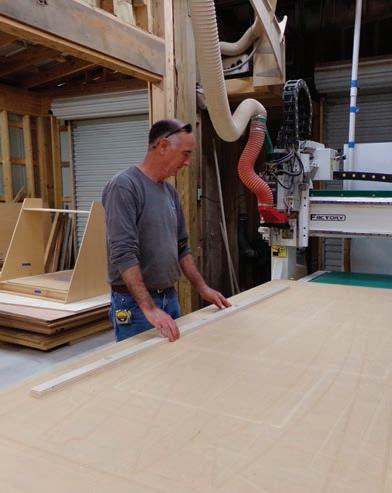
4 minute read
sure
by Summer Stevens
Construction manager Jared Arno is on his way to the field when he hears an emergency siren blaring. But it doesn’t alarm him. In fact, he hears this sound dozens of times a day coming from his pocket. It’s the ringtone on his cell phone. “It’s so I can hear it,” he said. That sound has to compete with massive heavy equipment in operation, the hum of the surf in the distance, and the wind that never stops on the soon-to-be-completed Rodanthe Bridge.
Arno is in charge of the day-to-day field operations of the 2.4-mile bridge project, including safety, quality, equipment, labor and subcontractor coordination. He works for Flatiron, the general contractor for the project. He oversees five superintendents, two on-site subcontractors and 90 hourly employees. Interestingly, because this bridge is built from both sides and works toward the middle, Arno runs identical crews on both the north and south sides, dividing his day between each crew. “It’s challenging managing that many moving parts and pieces,” he said.
His job starts at 6:30 a.m. with a meeting with superintendents and engineers to plan out the day. He coordinates meetings, trucking and crane use with workers out in the field. The day with the crew begins with a safety meeting and after that, Arno said, “I put out fires,” solving problems or addressing issues that inevitably come up daily in such a large-scale operation.
Additionally, because the water in the Pamlico Sound is so shallow – only about two feet in some areas – Flatiron is using an alternative method that is designed to protect sub-aquatic vegetation. “It has only been done a few times in the country,” Arno said. Typically, bridge projects use barges to haul heavy equipment and precast concrete beams to the right location. In contrast, the Rodanthe Bridge project has built an ever-moving railroad

Summer Stevens photo
Rodanthe Bridge construction manager Jerad Arno.
trestle, which they call the Advancing Rail System, alongside the bridge that moves right along with the progress. As the bridge is built, Arno’s team will disassemble the ends of the trestle and transport them to the front of the “line.” The innovative technique is designed to have less impact on the environment. “I don’t think people realize how many temporary structures we have to make to build a bridge,” he said.
The construction site is filled with specialized equipment. DEAL, based in Italy, supplies some of the massive heavy specialty equipment the project uses for the trestle system. The largest crane Arno’s crew uses has a capacity of 440 tons. Each of the piles, which are used to stabilize the bridge, is 150 feet long and weighs 150,000 pounds. The piles are driven 135 feet underground using a massive diesel hammer.
The sheer scale of the project is tempered somehow by the surrounding beauty. Crews work 10 to 12 hours a day, so they often see the sun rise and set. Despite the long hours, crewmembers wouldn’t trade it: “I don’t think I could work in an office,” Arno said as he looks at the glittering sound on one side and the Atlantic on the other. “I like being outside.”
But being outside along the North Carolina coast can be unpredictable. Some weeks go as scheduled and crews can work all week; other times rain and storms prevent progress. The goal is 137 feet of bridge per week on each side; totaling 274 feet. At this rate, the bridge will be completed toward the end of 2021 or early 2022.
“I love driving by every day and seeing the two sides getting closer and closer,” Arno said. The project broke ground in August 2018. The south side started first, and the north side is completing the bend. Pretty soon, he said, “it’ll just be a straight shot toward each other.” Once the two sides are connected, the concrete barrier railings will be poured and the bridge will be open to the public.
Not everyone is happy about the construction, however. Local residents and kiteboarders have expressed concern about the bridge obstructing their view and their hobby, respectively. But Arno, who has been working on bridges for 20 years, says this response early on is common. “In the end, when people start using the infrastructure we’ve built, people appreciate it,” he said. “Overall for the Outer Banks, it’s a good thing. People don’t like change, but in the end it’s good.”
It’s especially good for those who get stranded on either side of that section of NC 12 during a winter wind or northeast storm. “The ocean starts washing over the road,” Arno said, pointing to an area on coastline without any vegetation that doesn’t function as a barrier during high winds. “The bridge will bypass that road,” he said.
“A major hurricane can take out the Outer Banks, but this bridge will stay standing,” said safety manager CJ Frum. Arno agreed: “This bridge is built to last, that’s for sure.”














